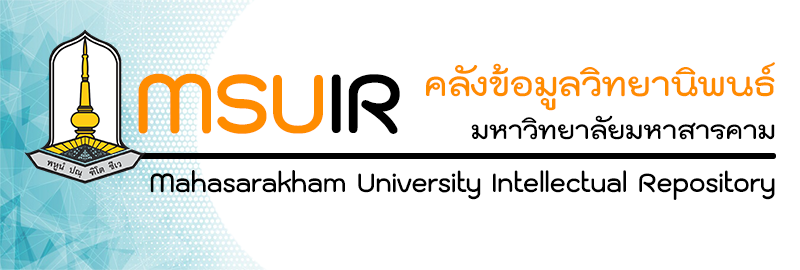Please use this identifier to cite or link to this item:
http://202.28.34.124/dspace/handle123456789/2673| Title: | The Optimal Design of Finite Impulse Response High Pass Filter Using Bee Colony Algorithm การออกแบบตัวกรองความถี่สูงผ่านดิจิตอลประเภทผลตอบสนองอิมพัลส์จำนวนจำกัดแบบเหมาะที่สุดโดยใช้ขั้นตอนวิธีฝูงผึ้ง |
| Authors: | Yotaka Tungtragul โยธกา ตั้งตระกูล Worawat Sa-Ngiamvibool วรวัฒน์ เสงี่ยมวิบูล Mahasarakham University Worawat Sa-Ngiamvibool วรวัฒน์ เสงี่ยมวิบูล worawat.s@msu.ac.th worawat.s@msu.ac.th |
| Keywords: | ตัวกรองความถี่แบบดิจิตอล, การหาค่าที่เหมาะสม, วิธีฝูงผึ้ง, ฟังก์ชันหน้าต่าง Digital filter Optimization Bee colony algorithm Kaiser window |
| Issue Date: | 26 |
| Publisher: | Mahasarakham University |
| Abstract: | Digital frequency filters play a crucial role in signal processing and are fundamental circuits in telecommunications. They are utilized in various measurement tools and electronic circuits, benefiting communication systems, antennas, control systems, and medical equipment. Digital frequency filters have been continuously invented and developed, and with different design methods available, designers can choose a method that is simple and suitable for the desired design. The goal of this study is to determine the optimal design of a finite impulse response high-pass filter using the Bee Colony Algorithm. However, challenges in designing frequency filters include the main lobe and relatively wide side lobe levels. There is a relatively high level of leakage, leading to unclear signals and considerable interference.
Therefore, this dissertation aims to address the aforementioned design issues of frequency filters by reducing the main lobe and side lobe sizes and decreasing the leakage factor. This will be achieved using the Kaiser window function in the MATLAB program, which presents an optimization technique based on the bee colony method to find suitable parameter values. and when compared to the given beta, simulation results reveal that the beta designed using the bee colony optimization method is more efficient in terms of the main lobe, reducing side lobe levels, and signal leakage factors. ตัวกรองความถี่แบบดิจิตอลมีบทบาทสำคัญในด้านการประมวลผลสัญญาณ และเป็นวงจรพื้นฐานด้านโทรคมนาคม ระบบเครื่องมือวัด และวงจรอิเล็กทรอนิกส์ต่างๆ ซึ่งถูกนำมาใช้ประโยชน์ในด้านระบบการสื่อสาร สายอากาศ ระบบควบคุม และทางด้านเครื่องมือแพทย์ ตัวกรองความถี่แบบดิจิตอลได้รับการคิดค้นและพัฒนาอย่างต่อเนื่อง โดยที่การออกแบบจะมีวิธีการที่แตกต่างกัน ผู้ออกแบบสามารถเลือกใช้วิธีที่ง่ายและเหมาะสมกับการออกแบบตามที่ต้องการ เป้าหมายของการศึกษานี้คือการออกแบบตัวกรองความถี่สูงผ่านดิจิตอลประเภทผลตอบสนองอิมพัลส์จำนวนจำกัดแบบเหมาะที่สุดโดยใช้ขั้นตอนวิธีฝูงผึ้ง แต่ปัญหาที่เกิดขึ้นในการออกแบบตัวกรองความถี่คือ โลบหลัก (Main lobe) และระดับของโลบรอง (Side lobe) ค่อนข้างกว้าง ปัจจัยการรั่วไหลมีมาก ทำให้เกิดสัญญาณมีความไม่ชัดเจน และมีการสอดแทรกของสัญญาณรบกวนมาก ดังนั้นดุษฎีนิพนธ์นี้จึงมีแนวคิดที่จะแก้ปัญหาการออกแบบตัวกรองความถี่ที่กล่าวมาข้างต้น ให้มีโลบหลัก (Main lobe), โลบรอง (Side lobe) มีขนาดลดลง และปัจจัยการรั่วไหลมีค่าลดลง โดยใช้ฟังก์ชันหน้าต่างไคเซอร์ ของโปรแกรม MATLAB โดยนำเสนอเทคนิคการหาค่าที่เหมาะสมโดยวิธีฝูงผึ้ง เพื่อค้นหาพารามิเตอร์เบต้าที่เหมาะสมที่สุด และเปรียบเทียบกับเบต้าที่กำหนด ผลการจำลองปรากฎให้เห็นว่า เบต้าที่ออกแบบด้วยวิธีฝูงผึ้งมีประสิทธิภาพที่ดีกว่าเบต้าที่กำหนดในแง่ของ โลบหลัก การลดระดับของโลบรอง และปัจจัยการรั่วไหลของสัญญาณ |
| URI: | http://202.28.34.124/dspace/handle123456789/2673 |
| Appears in Collections: | The Faculty of Engineering |
Files in This Item:
| File | Description | Size | Format | |
|---|---|---|---|---|
| 64010363003.pdf | 3.17 MB | Adobe PDF | View/Open |
Items in DSpace are protected by copyright, with all rights reserved, unless otherwise indicated.

